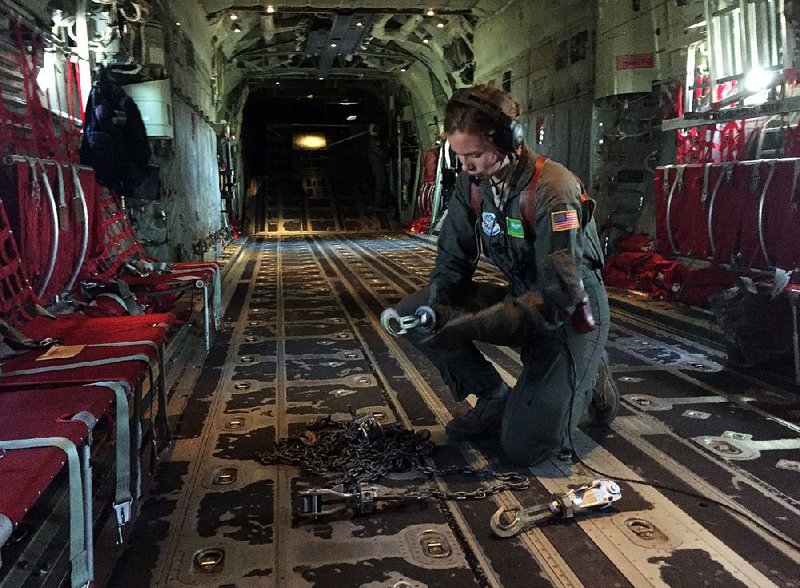When Airman 1st Class Devyn Freeze first climbed inside the cold, cavernous belly of a C-130 aircraft, she felt completely lost.
Freeze, now a loadmaster with the 61st Airlift Squadron at Little Rock Air Force Base, said it took "a good month" to assign meaning to every gauge, gadget and tool inside the 97-foot-long and 38-foot-tall plane.
More than a year and a half into her training, she wonders, "How do I have all this information in my head?"
Freeze, a sergeant, a pilot and a co-pilot took a training flight around Arkansas on Tuesday and allowed members of the media to tag along. They were "yanking and banking," making multiple touchdowns and liftoffs with little time in between, Freeze explained before she passed around motion-sickness bags.
(An Arkansas Democrat-Gazette reporter was thankful for that bag about two hours into the flight.)
Four planes flew a low-level route, dipping to between 300 and 1,000 feet above the ground. The goal was to practice loading and unloading airmen and equipment, including a Humvee, from the fuselage.
As the aircraft zigged and zagged over Arkansas terrain, rivers, roads, cars and their drivers appeared deceptively close.
"I swear I could reach out and touch it," Freeze said before she stood to peer out of the cockpit's windshield. She bobbed her head as music from a playlist titled "chill" streamed through her headphones.
Freeze's job was to oversee everything in the fuselage and support the co-pilot and the pilot, Capt. Zack Ratkovich. The job requires "situational awareness" and communication, she said. It was Ratkovich's first time flying that plane with a co-pilot and crew.
"It went well," he said after the plane's final touchdown. "Nothing's broken. I'd say that's a win."
The squadron will fly other flights while participating in a weeklong "Fly In." Aircraft from air bases in Ramstein, Germany; Yokota, Japan; Dyess, Texas; and other locations are congregating at Little Rock Air Force Base in Jacksonville for training and skill building.
Later in the week, those aircraft will engage in an "Elephant Walk," a mass formation flight, said spokesman 2nd Lt. Hunter Rininger.
Little Rock Air Force Base, known as the "Home of the Hercules," hosts the world's largest C-130 fleet for the U.S. Department of Defense.
There are about 58 C-130s on the "Team Little Rock" flight line at a given time, including 40 of the newer C-130J "Super Hercules" model, manufactured by Lockheed Martin Corp., according to the base's most recent economic-impact statement.
The C-130J is what Freeze called her "office" on Tuesday. It's "the most diverse and capable aircraft in the Air Force," Rininger said.
Compared with the older models, the C-130J has propellers with six blades instead of four, and the technological advancements remove the need for a flight engineer and navigator on board, Rininger said.
Instead, those functions are built into the plane through a digital map, weather updates and other upgrades. These duties are shared among a smaller flight crew -- often just a pilot, co-pilot and a loadmaster, who is responsible for everything that goes on or off the aircraft.
"If anything isn't working as well as it should, [the technology] lets us know," Freeze said.
As always, "there's a backup to the backup to the backup" if something doesn't work like it should, she added.
And, Freeze noted, the older models offered just a bucket for a bathroom. The C-130J, which can support up to 92 combat troops or 64 paratroopers, is equipped with a flushing toilet and a privacy screen.
"We're blessed, here," Freeze said with a smile.
As for duties, the Hercules and Super Hercules are among the most valuable players of military aircraft. They do it all: cargo, food and supply drops, search and rescue, aerial refueling and medical evacuation.
The inside of a C-130J, often crowded with hammocks and sleeping airmen, is roomy enough to fit a firetruck, Rininger said.
It's an ideal vessel for humanitarian aid, according to a Lockheed Martin fact sheet. More than 330 C-130Js are either delivered or have been ordered worldwide, according to the company.
Freeze said that's what makes her job so appealing: helping people who need it, like victims of last year's Hurricane Irma. Also, witnessing the sunrise and sunset on the same day, she said.
As the aircraft cruised over brown hills Tuesday, Freeze played videos of personnel drops that she had recorded on her phone.
Parachutes mushroomed, then disappeared into a square of blue sky outlined by an open door. Before a drop, standing toes to the edge of a ramp with the world 500 feet below is "the most exhilarating feeling," Freeze said.
Still, she said, her job isn't that different from any other position.
"You get up, you go to work," Freeze said, before she was cut off. An alarm was beeping. She grabbed a manual, flipped through it and told the pilot what he needed to know.
Metro on 03/14/2018
